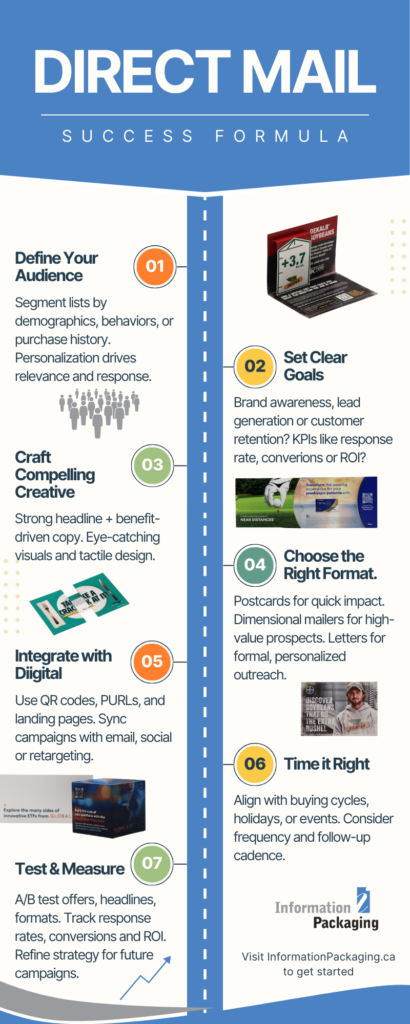Direct mail remains one of the most effective ways to reach your audience with a personal touch. But to get real results, it takes more than just sending out a flyer. Successful direct mail campaigns follow a clear, strategic formula, from defining your audience to testing and refining your approach. In this post, we’ll walk you through the 7 key steps that can help turn your direct mail into a high-performing marketing tool.
Here’s a breakdown of the 7 key steps to creating a successful direct mail campaign:
1. Define Your Audience
The foundation of any successful campaign is understanding who you’re targeting. Start by segmenting your audience based on demographics, behaviors, or purchase history. The more relevant your message is to the recipient, the better the response rate.
📌 Tip: Use personalization wherever possible (i.e. names, past purchases, or custom offers) to increase engagement.
2. Set Clear Goals
What are you trying to achieve with this campaign? Whether it’s brand awareness, lead generation, or customer retention, defining your objective is crucial. Set measurable KPIs such as response rates, conversions, or ROI to track performance and guide future decisions.
📌 Ask yourself: What does success look like for this campaign?
3. Craft Compelling Creative
A great message starts with a strong headline and benefit-driven copy. Pair this with eye-catching visuals and tactile design elements that stand out in the mailbox. Remember, your creative needs to do two things: grab attention and drive action.
📌 Don’t forget: A clear call-to-action (CTA) is essential. Tell the recipient exactly what to do next.
4. Choose the Right Format
Different audiences and messages call for different mail formats:
- Postcards for quick, visual impact
- Dimensional mailers for high-value prospects
- Letters for formal, personalized communication
📌 Choose based on your goals and audience preferences.
5. Integrate with Digital
Direct mail works best when combined with digital channels. Use QR codes, PURLs (personalized URLs), and custom landing pages to connect offline messaging with online engagement. Sync your campaign with email, social media, or retargeting ads to boost results.
📌 Pro Tip: Track digital interactions from your mailers to gather insights and measure impact.
6. Time It Right
Timing can make or break a campaign. Align your mail drops with buying cycles, holidays, seasonal events, or product launches. Also consider how often you’ll follow up—frequency and cadence matter for staying top-of-mind without overwhelming your audience.
📌 Test different send times to find what works best for your market.
7. Test & Measure
No campaign is complete without measurement. Use A/B testing on elements like offers, headlines, or formats. Track metrics like response rate, conversion rate, and ROI to see what’s working and where to improve.
📌 Use these insights to refine future campaigns and get better with each send.
Ready to Get Started?
Effective direct mail isn’t about sending more—it’s about sending smarter. By following this proven success formula, you can build campaigns that not only capture attention but also deliver meaningful results.
Visit InformationPackaging.ca to start building your next direct mail campaign with expert support. Click here to download our 7 Tips for Direct Mail Success.

